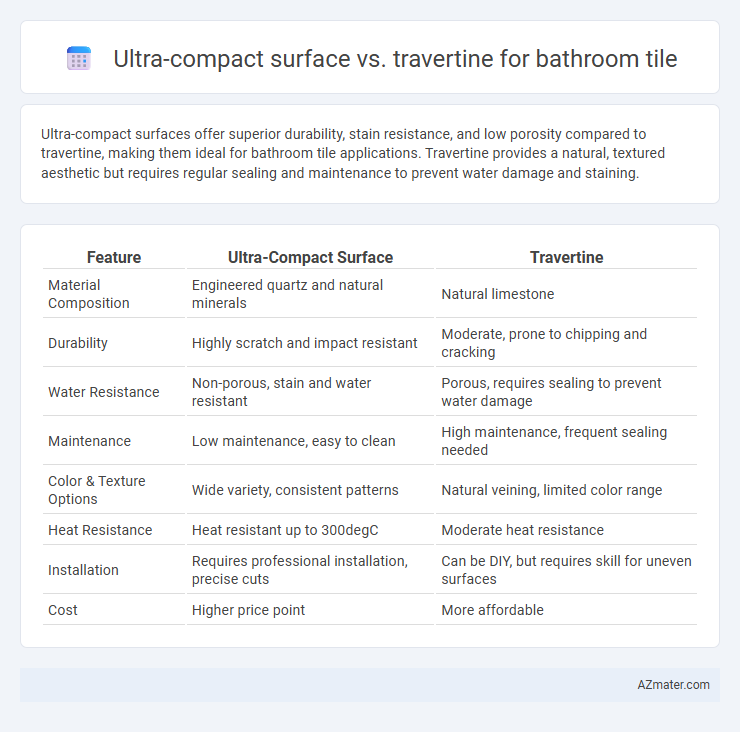Ultra-compact surfaces offer superior durability, stain resistance, and low porosity compared to travertine, making them ideal for bathroom tile applications. Travertine provides a natural, textured aesthetic but requires regular sealing and maintenance to prevent water damage and staining.
Table of Comparison
| Feature | Ultra-Compact Surface | Travertine |
|---|---|---|
| Material Composition | Engineered quartz and natural minerals | Natural limestone |
| Durability | Highly scratch and impact resistant | Moderate, prone to chipping and cracking |
| Water Resistance | Non-porous, stain and water resistant | Porous, requires sealing to prevent water damage |
| Maintenance | Low maintenance, easy to clean | High maintenance, frequent sealing needed |
| Color & Texture Options | Wide variety, consistent patterns | Natural veining, limited color range |
| Heat Resistance | Heat resistant up to 300degC | Moderate heat resistance |
| Installation | Requires professional installation, precise cuts | Can be DIY, but requires skill for uneven surfaces |
| Cost | Higher price point | More affordable |
Introduction to Ultra-Compact and Travertine Bathroom Tiles
Ultra-compact surface tiles offer exceptional durability, low porosity, and resistance to scratches and stains, making them a practical choice for bathroom floors and walls. Travertine tiles, a natural stone formed from calcium carbonate deposits, provide a classic, warm aesthetic with unique patterns and earthy tones, though they require regular sealing to maintain their appearance. Choosing between ultra-compact and travertine tiles depends on desired maintenance level, durability, and design preferences for bathroom spaces.
Material Composition: Ultra-Compact Surfaces vs Travertine
Ultra-compact surfaces are composed of a blend of natural raw materials like quartz, porcelain, and glass, sintered under extreme heat and pressure to create a dense, non-porous tile ideal for bathrooms. Travertine, a natural sedimentary limestone, contains calcite with natural pits and variations, requiring sealing to protect against moisture and stains. The engineered composition of ultra-compact surfaces offers superior durability and water resistance compared to the porous and softer mineral structure of travertine.
Design Aesthetics: Color, Pattern, and Visual Appeal
Ultra-compact surfaces offer a sleek, modern aesthetic with uniform color palettes and subtle patterns that mimic natural stone, enhancing minimalist bathroom designs. Travertine tiles provide a warm, organic appeal through their unique vein patterns and earthy tones, delivering a classic, timeless look. The choice between ultra-compact surfaces and travertine hinges on desired visual impact, with ultra-compacts favoring contemporary crispness and travertine emphasizing natural texture and variation.
Durability and Resistance to Wear
Ultra-compact surfaces, typically made from sintered stone, offer exceptional durability and high resistance to scratches, stains, and heat, making them ideal for high-traffic bathroom floors and walls. Travertine, a natural stone, is softer and more porous, requiring regular sealing to prevent wear and moisture damage in humid bathroom environments. Ultra-compact tiles provide superior long-term performance and minimal maintenance compared to the more delicate and maintenance-intensive travertine options.
Maintenance and Cleaning Requirements
Ultra-compact surfaces exhibit exceptional resistance to stains, scratches, and moisture, requiring minimal maintenance with just routine cleaning using mild detergents and water. Travertine, a natural stone, demands more frequent sealing to prevent water absorption and staining, alongside careful cleaning with pH-neutral products to avoid surface damage. The dense, non-porous nature of ultra-compact tiles ensures superior durability and easy upkeep compared to the porous, maintenance-intensive travertine in bathroom environments.
Water Absorption and Moisture Resistance
Ultra-compact surfaces exhibit exceptionally low water absorption rates, often below 0.1%, making them highly resistant to moisture and ideal for wet bathroom environments. Travertine, being a natural stone, has higher porosity and water absorption, typically ranging from 1% to 5%, requiring sealing to enhance its moisture resistance. The superior impermeability of ultra-compact tiles ensures long-lasting durability and hygiene in bathrooms, reducing risks of mold and water damage compared to Travertine.
Installation Process and Adaptability
Ultra-compact surfaces offer a more straightforward installation process for bathroom tiles due to their lightweight nature and uniform thickness, reducing the need for extensive substrate preparation compared to travertine. Travertine requires careful handling and skilled labor to manage its natural porosity and variation in thickness, often necessitating sealants and additional surface treatments to prevent moisture absorption. Ultra-compact tiles adapt better to complex layouts and curved surfaces, providing greater flexibility in modern bathroom designs while travertine excels in traditional, flat areas where its natural texture can be showcased.
Environmental Impact and Sustainability
Ultra-compact surface tiles boast a low environmental impact due to their efficient production process, which uses fewer raw materials and generates less waste compared to traditional travertine extraction that involves extensive quarrying, leading to habitat disruption and higher carbon footprints. These engineered tiles are also recyclable and often incorporate recycled content, contributing to sustainable building practices, whereas travertine's natural stone mining depletes non-renewable resources and is energy-intensive. Choosing ultra-compact surfaces supports eco-friendly bathroom designs by minimizing water consumption for maintenance and enhancing durability, reducing the need for frequent replacements common with porous travertine.
Cost Comparison and Long-Term Value
Ultra-compact surface tiles typically cost between $50 and $100 per square foot, while travertine ranges from $3 to $7 per square foot, making travertine initially more affordable. However, ultra-compact surfaces offer greater durability, resistance to stains and scratches, and lower maintenance costs over time, which enhances long-term value despite the higher upfront investment. Travertine requires regular sealing and is prone to damage, potentially increasing repair and replacement expenses in the bathroom environment.
Best Applications: Choosing the Right Tile for Your Bathroom
Ultra-compact surfaces excel in bathrooms requiring high durability, stain resistance, and minimal maintenance, making them ideal for countertops and shower walls exposed to heavy usage and moisture. Travertine offers a natural, warm aesthetic with unique textures, best suited for flooring and accent walls where visual appeal and slip resistance are prioritized over heavy exposure to water. Selecting between ultra-compact surface and travertine depends on balancing functional needs such as water resistance and durability with design preferences emphasizing natural beauty and texture.

Infographic: Ultra-compact surface vs Travertine for Bathroom Tile
 azmater.com
azmater.com